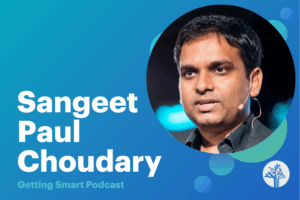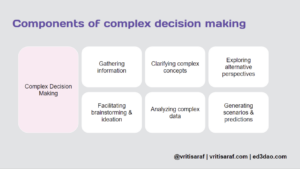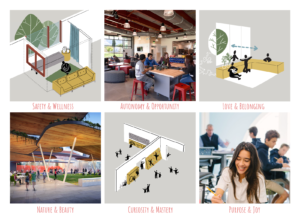Flipping the College Decision-Making Paradigm

Dr. Diane Hollems
Go ahead, try it.
Ask any adult, regardless of their education level, to recount how they approached the three choices – Major, College, Career – Ask them to describe, in order, which they choose first, then second and finally last.
They will probably tell you that the first thing they chose was the college they wanted to attend. They might have picked a parent’s alma mater, a party school, the one as far away from their parents as possible, or the one by the ocean or in a big city. After choosing a college, most settle next on a major, but usually not until they have attended for a couple of semesters. That choice is too often driven by what they were interested in at that time, the requirement by the college that it was “time” to choose in order to begin division classes or maybe even coaxed by a best friend to “major together.”
Finally, somewhere near or even after graduation, if they made it that far, they picked their career, and embarked onto the job to market, expecting to get hired. In today’s economy that is a rude awakening for student and parent alike. Today 8.5 percent of college graduates are unemployed or 16.8 percent are underemployed one year after graduation, according to The Economic Policy Institute in Washington, D.C.
Your final question, particularly if your interviewee has been out of school for many decades: “Do you think graduating high school students today make the same choices in the same order?” The answer is a resounding yes.
Then ask them, as self-aware, mature adults today, what the selection order should have been. The answer is shocking in its simplicity and it only takes moments for the person questioned to come up with the answer. Career first, major second, and college third. The order makes sense. Your career dictates what major to pursue, which in turn defines which colleges are appropriate. It is an ah-ha moment for most. Now they get it, but for many it’s too late.
The problem isn’t that students are not going to college; the problem is that they are not finishing. They are not finishing often because they find out they don’t like their major or don’t see the point of further education, they lose interest, and then decide to “figure it out later.” President Obama set a goal of the U.S. having the highest percentage of college graduates in the world by 2020. How do we get there? Start career planning earlier.
Career planning cannot start in the junior year of college. The research is clear: Students who enter college with an informed declared major are far more likely to graduate (by double), than those who wander through the maze of educational choices. At a time when education leaders are engaged in discussions about college completion, free community college and performance-based funding, some of the most obvious and effective solutions are right in front of us.
This simple flip of the college decision-making paradigm is how every student in America should approach their education.
So is there an answer? Yes, there is.
Students at more than 100 schools throughout the nation are flipping the college decision-making paradigm through the Get Focused…Stay Focused! (GFSF) Initiative.
In a GFSF program, all ninth grade students complete a semester or year-long freshman, (90 hour to 180 hour) comprehensive guidance course that helps students identify their interests and life goals, discover a career aligned to those interests and goals, and begin a unique skills-based 10-year education plan to prepare for that career. In some schools, students can receive dual enrollment college credit. And in some districts in California the 10-year plan is required for graduation.
During the 10th, 11th, and 12th grades students take a series of follow-up 16-lesson instructional modules that help them expand their career and education options and learn the process for selecting and applying to college or postsecondary training, identifying the skills needed for their chosen career and the plan required to get those skills both in the classroom and in the community.
This program goes beyond high school. There is a new mobile app, which facilitates the continuance of the career and education planning process. Students now have a tool to easily share their plans with advisors, counselors, friends and family. When inspiration strikes and a GFSF graduate learns something new, he or she can continue the self-discovery process of updating their 10-year plan.
Schools who adopt this program make a commitment of from 90 to 140 hours of classroom time over four years in the freshman course and later in the modules. It is not difficult to integrate the lessons, because they are academically based and meet the Common Core state standards. Instructors who deliver this hybrid course with fidelity will develop more motivated students.
The results make the commitment well worth it. Upon completion of the program, Get Focused…Stay Focused! students identify and graduate with:
- A carefully considered career path
- An informed major or program of study
- A post-secondary institution or training program that not only matches their career and life goals but is affordable
- A unique Skills-based Education Plan that facilitates successful entry into a highly competitive workforce upon completion of their education.
This program is successful in California, Oregon, New Jersey, and Kansas. Eastern Oregon University has adopted the GFSF model in their 22 Eastern Promise high schools. Recently in an Oregon Public Broadcasting interview the state superintendent called out this program as the one that showed great promise for helping that state tackle their state’s dropout problem.
And it doesn’t take long to see results. Indio High School in California started with the Freshman Transition course in 2009. The number of freshmen with three or more Fs decreased by nearly a half from 29 percent in 2009 to 16 percent in 2010 and freshmen were responsible for 49 of the school’s 65-point Academic Performance Index (API) increase within that first year.
But more than statistics this program changes the culture of your school. Said John Farinella, Principal of Rahway High School in New Jersey:
“The goals that are established in the 10-year plan then form the foundation for our guidance counselors and teachers to take those plans forward and continue to have those meaningful discussions with our students about how they are going to get through those plans.”
So the next time you’re in a discussion with friends and in conversation the topic turns to their college choices, ask them the College, Career, Major survey question – followed by the query: “what should it be?” They too will quickly realize the order that actually makes the most sense. This new realization to flip the paradigm of college-decision making choices will be an epiphany for them. Helping them understand the most direct route to a self-sufficient future will be doing parents, students and the economy a great service.
Please visit these online resources to learn more about the programs and research:
About “GenDIY”
Young people are taking control of their own pathway to careers, college and contribution. Powered by digital learning, “GenDIY” is combatting unemployment and the rising costs of earning a degree by seeking alternative pathways to find or create jobs they love. Follow their stories here and on Twitter at #GenDIY. For more on GenDIY check out:
- When I Grow Up: Helping Young Adults Explore Careers Collaboratively
- Creating Intrinsic Value, Interest and the Desire to Engage in Students
- Reconsidering Liberal Arts, the Gig Economy, and Global Trends for Generation DIY
Dr. Diane Hollems, Co-founder of the Get Focused…Stay Focused! ™ Initiative. Contact Diane at [email protected].








Bill Painter
What a fantastic idea! Would have saved me 1000's of dollars had I personally utilized this strategy as an incoming college freshman. More importantly, when I was served as Dean of Students at three separate colleges, I certainly saw the need!
Georgette Phillips
Dr Hollems hit the nail on the head! Career- Major -College IS the correct
Chris Powell
I am guilty of choosing my college first, then my major, then my career. How long did I last in my chosen field? A whopping 4.5 years. I am glad I have the tools now to help students across the country flip that college decision-making paradigm, especially my own children.
Lynell Wiggins
FUD! Fear, uncertainty, and doubt. For approximately 24 hours a day I listened, lived with, and stared into the eyes of developing college students as a residence life director. Often times I would hear, "someone told me I'm supposed to be in college, but how does this help me identify what I'm supposed to do with my life." Interestingly enough, I have seen the same look in the eyes of community college students I've worked with over the last 10 years. So I tell them that in a season of uncertainty it's important to connect with accurate information and a structure for making solid decisions. This article wholeheartedly confirms what I learned from the FUD in the eyes of my students; that focusing on one's career, major, and then college offers a great deal of occupational satisfaction because you're directing the majority of your attention on preparing yourself for that which creates the most consternation and befuddlement in your personal life (a career of course, second only to finding a spouse :)
Bert Bell
It makes so much more sense to choose Career - Major - College, but it never occurred to me at the time when I was making these decisions. Very likely because I was told from a young age, simply: "You need to go to college." As though that one choice would propel me into the career, and life that was best for me. I spent 4 years at a 2 year college trying to figure it out. I never did. With the pressure of keeping up my grades so that I could keep my financial aid, the drive to find my Career dwindled. I never graduated. I hope that with this shift in perspective, young people will have a better idea of what they want and how to get it BEFORE the pressure of adult and college life hits.
What an important conversation. Thank you, Dr. Hollems!
Matt Morgan
My career didn't exist when I was in high school (things change fast); part of it was starting to germinate when I was in college, while other parts of it (web/digital) didn't exist until I was already doing it. And I had no idea what I wanted to do for a career until I had been in one for about 5 years.
Thinking seriously about your future career is probably really valuable as a high schooler, but I would have picked wrong. Is anyone following these kids, and comparing them to college-bound kids who aren't doing the 10-year plan, and comparing results? Seems like that could be really interesting.
Bill Van Eron
I liked this and appreciate any progress made to help people see their potential sooner, refine key attributes and release the Kraken to a next generation of attribute driven skills and careers versus all teh jobs that box people in under the guise of specialists. I started a Higher Ed engineers program for 3 Fortune 100 companies where each saw it as "impossible". I see a major rift growing between industry risk aversion and an exponential rate of change, and universities laggard positioning struggling to keep up. I'd rather see graduating students in engineering and other knowledge areas move from university to advantaged new skills in industry, or as champions with a mix of right and left brain skills vital to challenging the status quo to make insight, systems and possibility thinking vital, as they proved to be for myself and high performance global teams. Will seek progressive universities and companies motivated to matter versus preserving outdated processes.